rockfish
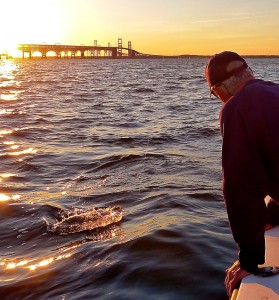 We’ve caught some very nice fish on Thunder Road over the past couple of weeks. Whether in the shallows or on the ledges, it’s fall on the Chesapeake Bay and time for trophy striped bass.
We’ve caught some very nice fish on Thunder Road over the past couple of weeks. Whether in the shallows or on the ledges, it’s fall on the Chesapeake Bay and time for trophy striped bass.
It’s a hot bite tonight. I’m fishing alone throwing topwater, a big chunky blue and silver Stillwater Smackit. Not my favorite plug, but pretty damn close. If you’ve read my book, you know where I am. If you haven’t, turn to page 50 in this month’s Chesapeake Bay Magazine and in his article, “Autumn Angling,” John Page Williams will tell you exactly where.
I’m right where John Page says I’ll be, working well inside the eight-foot-deep mark where the rocks come up to four. It’s a windy evening, too windy for topwater, but the bite is on and the fish don’t care.
There’s a full-moon-outgoing, so lots of current, too much current to stay over the spot for very long. The wind is blowing 17 knots from the northeast and building ahead of an approaching cold front. I’m drifting across the rocks way too fast. I compensate by slinging my lure as far as I can to lengthen my angle of attack. I imagine my fishing spot as a giant rectangular canvas with my lure painting a streak from the top corner to the bottom. The fish won’t hit unless I’m working the surface within four feet on either side of the underwater rocks. Unlike jigging where we work with portrait strike zones, for topwater, they’re landscape. Read More!
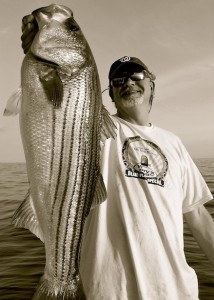 “There are no more deserts. There are no more islands. Yet there is a need for them. In order to understand the world, one has to turn away from it on occasion; in order to serve men better, one has to hold them at a distance for a time. But where can one find the solitude necessary to vigor, the deep breath in which the mind collects itself and courage gauges its strength? There remain big cities.” -ALBERT CAMUS from THE MINOTAUR.
“There are no more deserts. There are no more islands. Yet there is a need for them. In order to understand the world, one has to turn away from it on occasion; in order to serve men better, one has to hold them at a distance for a time. But where can one find the solitude necessary to vigor, the deep breath in which the mind collects itself and courage gauges its strength? There remain big cities.” -ALBERT CAMUS from THE MINOTAUR.
I must apologize for the lack of fishing reports lately. I’ve required some time to concentrate on other interests, dance for a while to the songs in my head, and step back to reassess some priorities after over-extending a little. I’m currently writing from a boat off the Florida Keys. I’ve been here for the past ten days or so. It’s been relaxing, rejuvenating actually, and I’ve enjoyed some successful fishing. My time for tuning out is about over, so next week I’ll be back working in the big city, and perhaps more importantly, back in the swing of the Chesapeake fishing scene. On August 20th I’ll speak to the Broadneck/Magothy MSSA chapter about Strike Triggers and Catch & Release techniques. The following night, August 21st, I’ll travel to the Essex/Middle River chapter to present a similar talk. On August 25th and 26th I’ll have a book-signing table and also give a couple of talks at the 6th Annual Maryland Buck Wild Outdoors Expo. Look for me all day Saturday and Sunday. Read More!
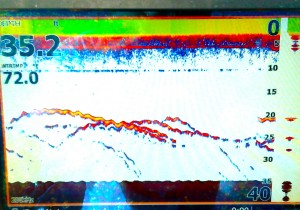 Suspended fish, I hate ‘em. Scattered fish suspending in deep water is one of the most difficult situations a light tackle angler will encounter on the Chesapeake Bay. In years past, I’ve refused to target suspended fish. I’d rather run fifteen additional miles looking for stripers feeding off the bottom than fool with the picky little snots. But, as Bob Dylan might say, The Times, They Are a Changin’. Bad water makes everything different. As predicted in my last entry, low oxygen levels have led to prolific algae blooms in the tributary rivers and in some areas of the main stem of the Bay. Conditions are worse around the western shore rivers since more people live there and there is more pollution.
Suspended fish, I hate ‘em. Scattered fish suspending in deep water is one of the most difficult situations a light tackle angler will encounter on the Chesapeake Bay. In years past, I’ve refused to target suspended fish. I’d rather run fifteen additional miles looking for stripers feeding off the bottom than fool with the picky little snots. But, as Bob Dylan might say, The Times, They Are a Changin’. Bad water makes everything different. As predicted in my last entry, low oxygen levels have led to prolific algae blooms in the tributary rivers and in some areas of the main stem of the Bay. Conditions are worse around the western shore rivers since more people live there and there is more pollution.
Pollution, especially nutrients like nitrates and phosphorus get into the Bay as a result of raw sewage dumping, storm-water runoff, and excessive fertilizer use. This makes the water very fertile, so small microscopic plants such as algae grow rapidly. The algae cells block sunlight, then die and sink to the bottom creating areas of low oxygen where fish can’t survive. Since dissolved oxygen levels were already at record lows this year, it didn’t take long for the blooming and decaying cycle to use up whatever oxygen was left. Read More!
![0321120733a[1]](http://www.chesapeakelighttackle.com/wp-content/uploads/2012/04/0321120733a1-300x225.jpg) “I only write when I’m inspired,” wrote William Faulkner. I’d find that statement comforting if he hadn’t followed it with, “and I’m inspired every morning at 9:00 AM.” Lately, my every-morning-at-9:00 AM-ritual hasn’t included much writing. Oh, I’ve had plenty to write about, it’s just that I’ve over-committed myself (again) so that every spare waking minute seems filled with obligation. When I have a spare hour, I usually go fishing. Since I bet you’d much rather hear about the fishing than the excuses, I’ll dive right in.
“I only write when I’m inspired,” wrote William Faulkner. I’d find that statement comforting if he hadn’t followed it with, “and I’m inspired every morning at 9:00 AM.” Lately, my every-morning-at-9:00 AM-ritual hasn’t included much writing. Oh, I’ve had plenty to write about, it’s just that I’ve over-committed myself (again) so that every spare waking minute seems filled with obligation. When I have a spare hour, I usually go fishing. Since I bet you’d much rather hear about the fishing than the excuses, I’ll dive right in.
There’s nothing more inspiring than a big fish. That’s Uncle Phill Anderson in the cover shot holding up a nice light-tackle fish he jigged up on a recent foggy morning in the mid-Bay. (Shhh, don’t tell the meat-fleet we’re picking off fish of this class with light tackle. It might catch on!) When I left off a month ago, I was smack in the middle of a series about strike triggers. I’m discussing why striped bass attack a lure, and how they are attracted to their prey. As previously mentioned, almost any lure or technique will work on hunger-feeding fish. Unfortunately, most of us don’t have the time or resources to always go fishing at the places where hungry fish are most abundant. We have to fish in the limited time we have available, and usually very close to home. While we may occasionally encounter groups of ravenous fish, most of the stripers in our neighborhoods are pretty hard to catch. In order to be consistently successful, we have to provoke strikes from fish that may not be inclined to bite by appealing to their five senses. I’ve written about sight, sound, and feel. This entry completes the strike triggers series with a look at smell and taste. Read More!
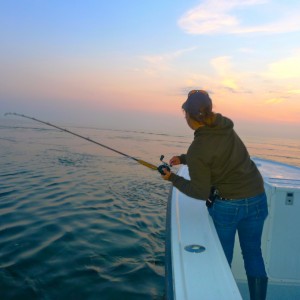 In the last CLT entry, I wrote about the five reasons why Chesapeake Bay stripers attack a lure: hunger, reaction, competition, territory protection, and curiosity. When fish are hungry, they’re easy to catch. Almost any lure or technique will work on hunger-feeding fish. Unfortunately, most of us don’t have the time or resources to constantly run around looking for schools of voracious fish. If you’re like me, you have to fish in the limited time you have available, and you probably stay close to home. While we may occasionally happen upon groups of ravenous fish, most of the stripers we encounter are hard to catch. In order to be consistently successful, we have to provoke strikes from fish that may not be particularly inclined to bite. Strike producing lures are especially important right now since we have trophy rockfish migrating in and out of the Bay. Our chances for catching-and-releasing a 50-pounder on light tackle are better than at any other time of year, but migrating fish have other things on their minds besides eating. Big fish get bigger by being smart and getting smarter. To catch them, we need to cast lures that will provoke strikes by appealing to their five senses; sight, sound, smell, feel and taste. I call the formula 5 by 5. By that, I mean we can consider the five reasons why fish strike, then use lures designed to appeal to each of their five senses in order to come up with the best of all possible strike triggers. In this installment we’ll look at striped bass eyesight. Read More!
In the last CLT entry, I wrote about the five reasons why Chesapeake Bay stripers attack a lure: hunger, reaction, competition, territory protection, and curiosity. When fish are hungry, they’re easy to catch. Almost any lure or technique will work on hunger-feeding fish. Unfortunately, most of us don’t have the time or resources to constantly run around looking for schools of voracious fish. If you’re like me, you have to fish in the limited time you have available, and you probably stay close to home. While we may occasionally happen upon groups of ravenous fish, most of the stripers we encounter are hard to catch. In order to be consistently successful, we have to provoke strikes from fish that may not be particularly inclined to bite. Strike producing lures are especially important right now since we have trophy rockfish migrating in and out of the Bay. Our chances for catching-and-releasing a 50-pounder on light tackle are better than at any other time of year, but migrating fish have other things on their minds besides eating. Big fish get bigger by being smart and getting smarter. To catch them, we need to cast lures that will provoke strikes by appealing to their five senses; sight, sound, smell, feel and taste. I call the formula 5 by 5. By that, I mean we can consider the five reasons why fish strike, then use lures designed to appeal to each of their five senses in order to come up with the best of all possible strike triggers. In this installment we’ll look at striped bass eyesight. Read More!
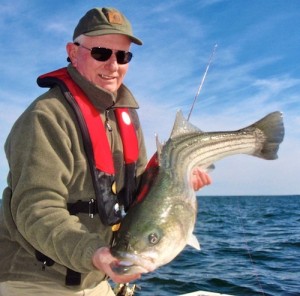 Last December, I caught up with my friend Gaylon Thompson at one of my light tackle seminars in Severna Park, Maryland. During the few minutes we had to talk, we wondered if we might be able to get in a fishing trip in early 2012. I was very excited when Rich Jenkins called me last week to say he and Gaylon were heading down to Virginia to fish in the ocean Monday, and I was invited. He also invited Jamie Clough. We’ve been hearing about the coastline bite for a while now from Wild Bill and other fishermen who follow the migration. Even though I’m turning up a few hard-to-catch but very big fish here in the Bay, we couldn’t resist giving it a go. Our first challenge was deciding whether to fish the Chesapeake Bay Bridge Tunnel, or the ocean. We called, emailed, and Facebooked everyone we could think of seeking advice. Some of our friends came though, especially “Hillbilly Boater” Jack, and a couple of Jamie’s buddies. I also got some good info from some of Tattoo Charlie’s buds on Facebook. Read More!
Last December, I caught up with my friend Gaylon Thompson at one of my light tackle seminars in Severna Park, Maryland. During the few minutes we had to talk, we wondered if we might be able to get in a fishing trip in early 2012. I was very excited when Rich Jenkins called me last week to say he and Gaylon were heading down to Virginia to fish in the ocean Monday, and I was invited. He also invited Jamie Clough. We’ve been hearing about the coastline bite for a while now from Wild Bill and other fishermen who follow the migration. Even though I’m turning up a few hard-to-catch but very big fish here in the Bay, we couldn’t resist giving it a go. Our first challenge was deciding whether to fish the Chesapeake Bay Bridge Tunnel, or the ocean. We called, emailed, and Facebooked everyone we could think of seeking advice. Some of our friends came though, especially “Hillbilly Boater” Jack, and a couple of Jamie’s buddies. I also got some good info from some of Tattoo Charlie’s buds on Facebook. Read More!


